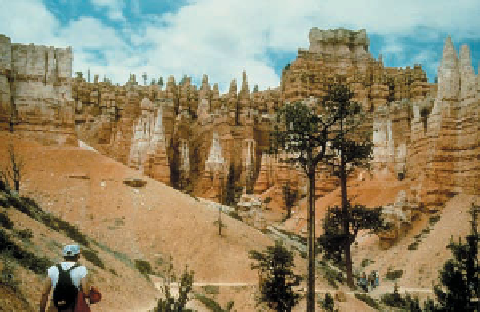Geology Reference
In-Depth Information
A variety of large mammals and birds existed during
the Pleistocene.
Many large land-dwelling mammals became extinct at
the end of the Pleistocene.
Primates were present throughout the Cenozoic; how-
ever, human evolution took place during the Pliocene
and Pleistocene.
At 66 million years long, the Cenozoic Era makes up only
1.4% of all geologic time, or just 20 minutes on our hypo-
thetical 24-hour clock (see Figure 19.1). Although brief in the
context of geologic time, by any other measure, the Cenozoic
is longer than we can even imagine, certainly long enough
for signifi cant evolution of Earth and its biota.
Geologists divide the Cenozoic into two periods of unequal
duration. The Paleogene Period (66 to 23 million years ago)
includes the Paleocene, Eocene, and Oligocene epochs, and the
Neogene Period (23 million years ago to the present) includes
the Miocene, Pliocene, Pleistocene, and Holocene or Recent
epochs (see Figure 1.17). However, you will see publications
with the Cenozoic made up of the Tertiary and Quaternary
periods because Paleogene and Neogene have only recently
replaced these terms. In any event, Tertiary and Quaternary are
no longer recommended for subdivisions of the Cenozoic Era.
Geologists know more about Cenozoic Earth and life
history because Cenozoic rocks, being the youngest, are the
most accessible at the surface or just below the surface. Vast
exposures of Cenozoic sedimentary and volcanic rocks in
western North America (see the chapter opening photograph
■
■
■
One reason to study Cenozoic Earth and life history is that the
present distribution of land and sea, oceanic and atmospheric
circulation patterns, and Earth's present distinctive topog-
raphy and biota evolved during that time. For instance, the
Appalachian Mountains began their overall evolution during
the Proterozoic Eon, but their present distinctive topography
resulted largely from Cenozoic uplift and erosion. Likewise,
the Sierra Nevada of the western United States, the Himala-
yas in Asia, and the Andes in South America owe their char-
acteristics to Cenozoic events.
◗
Figure 23.1
Cenozoic Rocks are widespread in the western part of the country
a
,
b
,
c
, but are
found in only a few areas in the east
d
.
The Miocene Lovejoy Basalt near Orland, California, caps
the small hill in the distance.
c
The Paleocene Fort Union Formation in Montana.
a
b
The Wasatch Formation in Bryce Canyon National Park
in Utah was deposited during the Eocene.
Miocene- and Pliocene-age sedimentary rocks in the Calvert
Cliffs of Maryland.
d










Search WWH ::

Custom Search